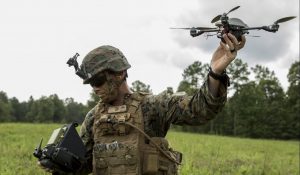WASHINGTON: Special Operations Command is asking drone makers to bring a slew of new technologies down to Florida in November to assess a range of novel gear, and they’re particularly interested in tiny drones: everything from 1-lb. drones that can fly without GPS to systems that can carry 10 lbs. of blood on the battlefield to wounded commandos.
The fly-off comes a few months after special operations leadership declared that practically everything their troops are using in the field today is considered “legacy” equipment, calling for a wholesale upgrade.
In documents asking industry to come down to Florida to show off their new gear, SOCOM said that everyone from “industry, academia, individuals, and Government labs” are invited to submit technology “leading to possible Government/Industry collaboration for development of USSOCOM technology capabilities.” (That openness is belied by the fact that all travel and other expenses will be the responsibility of the drone makers, which could put the squeeze on some smaller groups.)
The small drones should be able to do a variety of things — take off anywhere, attach themselves to power lines or use solar energy to recharge, fly indoors or out, operate during day or night, mesh with other drones in a swarm, and operate autonomously after their GPS has been disabled.
The requirements point to the thinking in the Pentagon about where and how future conflicts will shake out, namely, dense urban environments. The drones are being asked to check in at no more than 1.5 lbs., and sound like they would be effective in urban environments, where no runways exist, and where the electronic clutter will be high.
West Point has established an Urban War Institute to begin working through these issues, and Army chief Gen. Mark Milley has said that his staffers are working under the idea that “In the future, I can say with very high degrees of confidence, the American Army is probably going to be fighting in urban areas.”
In fact, they already have. The bruising fights in Fallujah in 2004, and Sadr City in 2008, showed the Marine Corps and Army how difficult it is to fight in densely-packed city streets where every building presents a new danger. More recently the bloody, door-to-door punch-outs the U.S.-backed Iraqi army endured in Mosul and the Syrian Democratic Forces experienced in Raqqa, gave a reminder of the grinding nature of urban combat. (See Stalingrad etc)
In a significant admission, the documents say the small drones they’re looking to experiment with should be able to operate “without owning the air domain,” a nod to the realities of battlefields where opponents will have their own drones and will be waging electronic warfare that may be superior to US weapons. That’s a far cry from the unrivaled dominance U.S. troops have had on the battlefields of Iraq and Afghanistan, where they could operate freely without worrying about what was flying overhead, or who might be listening in or jamming their communications.
One of the drones, described as a “Nano” should have a takeoff weight of 75 grams — less than a pound — while offering day and night imaging, autonomous flight modes and indoor flight capability. Another, the “Micro” drone, should come in at 1.5 lbs., and have all those capabilities, along with all weather operation and the ability to operate in underground tunnels and caves.
The monster of the bunch, a vertical take-off fixed-wing drone weighing no more than 7.5 lbs. Should be able to operate without launch or recovery equipment.
One particularly intriguing system is a blood-delivery drone, that should be able to carry at least 10 lbs. of blood at least 100 miles to operators working in austere environments. The drone must be able to keep the blood at around 35 to 40 degrees Farenheit during the flight.
The ambush of a small team of Green Berets in Niger in October of last year — which left four soldiers dead and two wounded — highlighted how critical it is for commandos to have some access to the “Golden Hour” that U.S. troops had relied on in Iraq and Afghanistan, where airlift within an hour for wounded troops was critical to their survival. Of course, special forces are often simply beyond the reach of the infrastructure found in persistent combat zones.
To try and meet that need, SOCOM also said in its solicitation that it is looking for, “far-forward austere casualty care to sustain critically injured personnel until they can reach the next higher level of care,” and “the equipment must be easy to use, require minimum maintenance, and have low power consumption. Drugs and biologics should not require refrigeration or other special handling.”
Major trends and takeaways from the Defense Department’s Unfunded Priority Lists
Mark Cancian and Chris Park of CSIS break down what is in this year’s unfunded priority lists and what they say about the state of the US military.



























